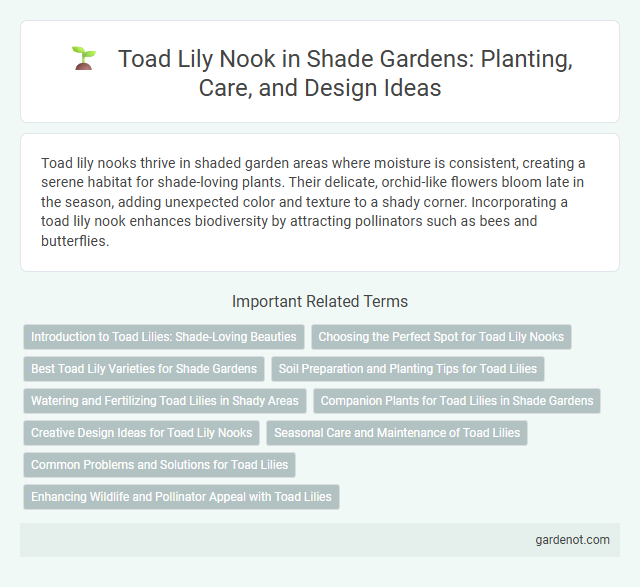Toad lily nooks thrive in shaded garden areas where moisture is consistent, creating a serene habitat for shade-loving plants. Their delicate, orchid-like flowers bloom late in the season, adding unexpected color and texture to a shady corner. Incorporating a toad lily nook enhances biodiversity by attracting pollinators such as bees and butterflies.
Introduction to Toad Lilies: Shade-Loving Beauties
Toad lilies (Tricyrtis) are shade-loving perennials prized for their unique, orchid-like flowers that bloom in late summer to fall, bringing late-season interest to shade gardens. These plants thrive in moist, well-drained woodland settings, displaying speckled, star-shaped blossoms in shades of purple, white, and pink that attract pollinators. Ideal for shady nooks and underplanting beneath trees, toad lilies combine delicate beauty with low maintenance, making them essential in creating vibrant, shaded garden spaces.
Choosing the Perfect Spot for Toad Lily Nooks
Toad lily nooks thrive in shaded areas with well-draining, humus-rich soil that retains moisture without becoming soggy. Select a location protected from harsh afternoon sun, ideally under deciduous trees or along shaded garden borders where dappled light filters through. Ensuring consistent soil moisture and shelter from strong winds enhances the delicate blooms of Tricyrtis, creating a vibrant and serene shade garden feature.
Best Toad Lily Varieties for Shade Gardens
The best toad lily varieties for shade gardens include Tricyrtis hirta, known for its star-shaped, speckled lavender flowers and ability to thrive in deep shade. Tricyrtis 'Purple Splendor' offers striking purple blooms with distinctive dark spots, adding visual interest to dim garden corners. Tricyrtis 'Miyazaki' stands out for its large, orchid-like flowers in soft pastel hues, perfect for enhancing moist, shaded garden nooks.
Soil Preparation and Planting Tips for Toad Lilies
Toad lilies thrive in well-drained, humus-rich soil with a slightly acidic to neutral pH (5.5-7.0), ideal for shade garden environments. Prepare the planting site by incorporating organic matter such as compost or leaf mold to enhance moisture retention and soil fertility. Plant toad lily rhizomes 1-2 inches deep and space them 12-18 inches apart to ensure adequate air circulation and growth.
Watering and Fertilizing Toad Lilies in Shady Areas
Toad lilies thrive in consistently moist, well-drained soil, so watering them regularly during dry spells is essential to maintain their delicate blooms in shady garden areas. Applying a balanced, slow-release fertilizer in early spring supports healthy foliage and vibrant flowers, promoting a lush growth habit throughout the growing season. Mulching around the base helps retain soil moisture and regulate temperature, ensuring optimum conditions for the shade-loving toad lily.
Companion Plants for Toad Lilies in Shade Gardens
Toad lilies thrive alongside shade-loving companions such as hostas, ferns, and astilbes, which share similar moisture and light requirements. These companion plants enhance the garden's texture and color contrast while supporting the delicate growth needs of toad lilies in shaded, woodland environments. Planting them together creates a harmonious and vibrant understory optimized for low-light garden settings.
Creative Design Ideas for Toad Lily Nooks
Incorporate diverse shade-loving perennials like hostas and ferns around Toad Lily nook to enhance textural contrast and seasonal interest. Utilize natural stone pathways and mulch to define the space while ensuring proper moisture retention for toad lilies. Consider vertical elements such as trellises or woodland-inspired screens to create depth and a secluded ambiance in your shade garden design.
Seasonal Care and Maintenance of Toad Lilies
Toad lilies thrive in shaded, moist environments and require consistent watering, especially during dry periods, to maintain vibrant blooms throughout the fall season. Applying a layer of organic mulch helps retain soil moisture and regulates temperature, promoting healthy root development. Regular removal of spent flowers and damaged foliage encourages prolonged blooming and reduces the risk of fungal diseases.
Common Problems and Solutions for Toad Lilies
Toad lilies often face problems such as powdery mildew, slugs, and insufficient shade that can hinder growth in a shade garden. Managing powdery mildew involves improving air circulation and applying fungicides, while controlling slugs requires natural predators or barriers like copper tape. Ensuring the toad lily nook maintains consistent moisture and dappled shade optimizes plant health and vibrant blooms.
Enhancing Wildlife and Pollinator Appeal with Toad Lilies
Toad lily nooks create vibrant habitats that enhance wildlife presence by attracting beneficial pollinators such as bees, butterflies, and hummingbirds. These shade-loving perennials bloom in late summer to fall, providing essential nectar sources when other flowers have faded. Incorporating toad lilies in a shade garden supports biodiversity and promotes a thriving ecosystem for pollinators and other small wildlife species.
Toad lily nook Infographic

 gardenot.com
gardenot.com